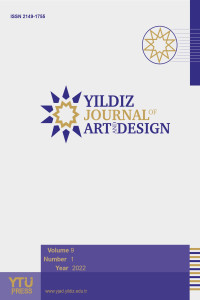The Impact of a Proposed Instructional Program Based on Image Analysis to Develop Concepts of Non-violence among Upper Basic Stage Students
Instructional Program, Image Analysis, Concepts of non-violence, Upper Basic Stage.
The Impact of a Proposed Instructional Program Based on Image Analysis to Develop Concepts of Non-violence among Upper Basic Stage Students
___
- Abdul Hamid, S. (2005). Image era: negatives and positives. Kuwait: The National Council for Culture, Arts and Letters.
- Abdullah, A., & Omariya, B. (2021). The effectiveness of the guidance program in reducing school violence among primary school students. Journal of Educational and Social Studies, 10(2), 397–412.
- Abu Nasser, F. (2015). The impact of proposed photography program on the development of creative abilities of third grade students at intermediate school in Jeddah. Journal of Psychological and Educational Sciences, 13(2), Article 335.
- Abu Sitta, F., & Al-Dalil, M. (2016). Effectiveness of reading pictures in enhancing students’ appreciation of art in faculty of Specific Education. Department of Artistic Education, 71, 509–538.
- Al-Dulaimi, A. (2011). Indications of violence in students’ drawings. Dirasat Tarbawiya, 4(13), 59–90.
- Alnajaar, A. (2018). The effectiveness of communication skills collective guidance program in reducing the level of school violence among students with learning difficulties. Journal of Educational Sciences, 15, 295–352.
- Al-Atoum, M. (2018). The effect of using conceptual maps on the achievement of eighth grade students in art education. Journal of Research in Specific Education, 19(1), 1–33.
- Alsaggar, M. (2013). Arts education and the issues of production of the image. The Jordanian Journal of the Arts, 6(1), 103-111.
- Denis, M. (1989). Image et cognition. (1st ed.). PUF.
- Elkins, J. (2011). What is an Image? (2nd ed.). Penn State Press. [CrossRef]
- Gage, B. J. (2010). Cognition, brain, and consciousness: Introduction to cognitive neuroscience (2nd ed.). Academic Press.
- Gaskell, P. A. (2000). Qualitative researching with text, image and sound: A practical handbook for social research (1st ed.). SAGE Publication. [CrossRef]
- Hirobumi, N. A. (2012). Structural analysis and description of curves by quasi-topological features and singular points,. In H. S. Yamamoto (Ed.), Structured document image analysis (pp. 138-169). Springer.
- Julie, M. (2014). Introduction to image analysis. Damascus: Ministry of Culture, Arabic translation by Nabil Dibs.
- Kir, S. (2019). New media and visual communication in social networks (1st ed.). IGI Global.
- Manovich, l. (2001). The language of new media (1st ed.). MIT Press. [CrossRef]
- Olowo, O. O. (2016). Effects of integrating peace education in the Nigeria education system. Journal of Education and Practice, 7(18), 9–14.
- Parker, M. H. (2014). Authenticity when viewing works of art Human cortical activity evoked by the assignment of Mengfei Huang. In R. J. Martinez (Ed.), Brain and Art (pp. 134-152). Frontiers.
- Plataniotis, R. L. (2018). Color image processing: Methods and applications. CRC Press.
- Pöppel, E. (2007). Auf der Suche nach der Landkarte des Wissens: Interview mit Stefan Krempl. In R. A. Niehoff, Denken und Lernen mit Bildern. Interdisziplinäre Zugänge zur Ästhetischen Bildung (pp. 306–312). München. [Deutsch]
- Sadiq. M. (2018). Training program based on some habits of mind in decrease scholar violence for the primary school student. Journal of Psychological Guidance, 56, 199–246.
- Serrat, J., Marti, J., Benedi, J. M., & Mendonça, A. M. (Eds.). (2007). Pattern recognition and image analysis: Third iberian conference, IbPRIA 2007. Springer.
- Wulf, C. (2009). Anthropologie: Geschichte - Kultur –Philosophie (1st ed.). Anaconda.
- Wulf, C. (2014). Bilder des menschen, imaginäre und performative gr
- Başlangıç: 2013
- Yayıncı: Yıldız Teknik Üniversitesi
Sürdürülebilir tüketim davranışları üzerine sürdürülebilir sanat
ÜNİVERSİTE BİRİM LOGOLARININ GÖRSEL KİMLİK BAĞLAMINDA DEĞERLENDİRİLMESİ
LİF SANATI LİTERATÜRÜNE GİRMİŞ ÖNCÜ KARIŞIK MEDYA UYGULAMALARI
Tutku Ceren AKÇAM, Neslihan ŞİRİN YAŞAR
Sanat ve Tasarımda Gerçeküstü Mizah: Marx Ernst ve Jan Lenica
